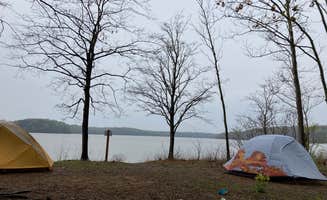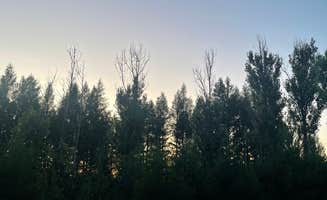Dispersed camping near Ellettsville, Indiana offers primitive backcountry experiences primarily in the Hoosier National Forest. Most sites require standard Forest Service rules including camping at least 200 feet from trails and water sources. Winter camping remains accessible on most forest roads when conditions permit, though several access routes become difficult or impassable after heavy rainfall.
What to do
Hiking access to water: Peninsula Trail offers numbered backcountry campsites that provide lake access with hiking distances varying between sites. "On the peninsula trail, there are multiple campsites with fire rings but you may also camp anywhere if you are at least 100 ft from the water. Campsite #18 has a great view and is large enough for at least 4 tents if you have a big group," notes camper Aspen B. at Peninsula Trail.
Stargazing opportunities: The Deam Wilderness area provides relatively dark sky conditions for astronomical viewing. "Light pollution is pretty low however, so good stargazing," reports Matt V. about his experience at Peninsula Trail. Sites further from the main roads typically offer better night sky visibility.
Local wildlife observation: During spring and fall migrations, bird watching opportunities increase throughout the forest. "I assumed it was a pack of cayotes and they would leave once I started banging on stuff and primally yelling," mentions Reuben R. about wildlife encounters at Berry Ridge Road. Visitors should maintain proper food storage to prevent attracting wildlife.
What campers like
Site privacy: Many dispersed areas provide significant seclusion between camping locations. Jacob notes about Berry Ridge, "tons of camp spots sometimes half mile or more apart haven't seen any snakes here either and the best part I haven't seen any people!" This separation provides exceptional privacy compared to developed campgrounds.
Low traffic volumes: Forest service roads leading to most sites see minimal traffic, especially on weekdays. "Just a few sites along the road minimum traffic encountered," reports David S. about BerryRidge Road Dispersed Camping, making these locations considerably quieter than established campgrounds.
Accessibility for standard vehicles: While high-clearance vehicles provide advantages, many sites remain accessible with passenger cars during dry conditions. Jimmy H. mentions about Hickory Ridge Primitive Dispersed Campsites: "I pulled in at midnight in a sedan in the winter and i was able to safely find my way. Very nice drive during the day, hiking is fantastic!"
What you should know
Road conditions vary significantly: Access roads range from maintained gravel to rutted forest tracks that deteriorate quickly after rain. "I have a promaster conversion and had no trouble making it to this site, however the road was gravel and steep at times," notes Amber R. about Berry Ridge Road conditions.
Pack-in, pack-out requirements: No trash facilities exist at these locations. "Free disbursed camping at its best in Indiana. Not another soul camped within earshot. Clean site. Gravel pad for vehicle. Green grass for tent. 14 day limit," explains Jef C. at Sundance Lake Dispersed Camping.
Limited or no cell service: Connectivity becomes unreliable throughout much of the forest. At Sundance Lake, julie notes: "National forest area with 3ish campsites one of which can accommodate a vehicle. Wooded so no solar or starlink. Small lake nearby with what looks like some trails."
Tips for camping with families
Choose accessible sites: For family camping, select locations with shorter hiking distances. "It was an awesome backpacking journey for starters, little bit rough because of the horse riding track but awesome if you love to walk and see nature," shares Osiel M. about Peninsula Trail, indicating its suitability for introducing children to backpacking.
Plan for water needs: No potable water exists at any dispersed sites, requiring families to carry sufficient supplies. "Long walk to the water so make sure you bring plenty of drinking water. Springs available in the valleys but watch for timber rattlesnakes," warns Elliot F. from his Peninsula Trail experience with children.
Educational opportunities: These areas provide natural science learning experiences without electronic distractions. Hickory Ridge reviewer Jase G. notes: "Good spot to get some quiet time to learn/hone skills or for some good quality time with the family while being plugged into nature and unplugged from their electronics."
Tips from RVers
Size restrictions matter: Most dispersed sites accommodate only small trailers or vans rather than full-sized RVs. "Some sites, at least one, could fit a pretty good sized camper. This is pack in pack out, no amenities camping for free," Jeremy F. mentions about Berry Ridge Road.
Consider leveling requirements: Many forest sites feature uneven terrain requiring leveling blocks. Steven G. reports about Sundance Lake: "At the pond there was a pad of concrete leftover from who knows what. I wouldn't be trying to pull a travel trailer back into here unless it was very small."
Scout ahead when possible: For larger vehicles, walking the access road before committing prevents potential issues. "This is my first time camping solo. I was definitely nervous at first and almost debated getting back on the road before sundown," shares Palynn F. about Berry Ridge Road, indicating the importance of site evaluation.



